LESSON 14.2 – Conjugating ‘te’ form, expressing ‘please’, ‘how to’ and ‘shall I’, giving directions and progressive actions With that, we conclude Level 2 of Japanese Language! Let’s review important conjugation of verbs, questions words… More
Day #2.10.1
Lesson 14 (Part I)
- Verbs and the ‘て | te’ form of verbs
- Making requests with ‘て ください | te kudasai’
The ‘te’ form of verbs are classified into 3 types of groups:
- Those that end with ‘i’; namely, い ち り み び に き ぎ し
Lesson #13.2
Lesson 13 (Part II)
- Go in/ go out of ~ (house, building, a room)
- Expressing go/come + [verb – to do something]
1a. GO INTO ~
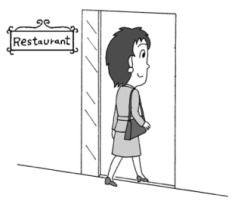
レスラン に はいります。 | I go into the restaurant.
スーパー に はいります。 | I go into the supermarket.
1b. GO OUT OF ~
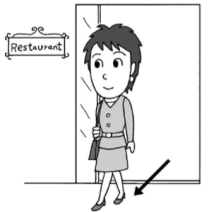
レスラン を でます。 | I go out of the restaurant.
うち を でます。 | I go out of my house.
Note that the particle changes when referring to entering and leaving.
2. [PLACE] + GO/ COME TO DO + [VERB]
Some additional vocabulary:
なにか | something
どこか | somewhere/ anywhere
なにか のみたいですね。 | I want something to drink.
やすみに どこかへ いきましたか。| Did you go anywhere in the holidays?
To express that you go/ come to do an activity at a place: Because “going”/ “coming” is a verb, the action that comes before needs to be conjugated.
飲みものを 買います | Buy drinks – – – – > 飲みものを 買いに
The verb in its ‘masu’ form conjugates to become ‘ni’ form.
スーパーへ 飲みものを 買いに 行きます。 | I go to the supermarket to buy drinks.
ロンドンへ えぶんけんきゅ の べんきょうを しに きました。 | I came to London to study Literature.
3a. GO/ COME TO DO [VERB]
オーチャードへ 何を しに 行きますか。 | What do you do when you go to Orchard?
3b. GO/ COME TO DO [ACTION]
どこへ おみやげ を 買いに いきますか。| Where do you go to buy souvenirs?
Day #2.9.1
Lesson 13 (Part 1)
- Describing desires – “I want [noun]” & “I want to [verb]”
1. WANT [NOUN]
The stem word “want” is categorised as an ‘i adjective’, and it is ‘ほしい | hoshii’ in Japanese. We’ve learnt from the previous Lesson 12 (Parts I – III) that ‘i adjectives’ conjugate differently from typical nouns and ‘na adjectives’.
Conjugation for ‘ほしい | hoshii’:
(い adjective) Positive Negative
Present ほしいです ほしくないです
Past ほしかったです ほしくなかったです
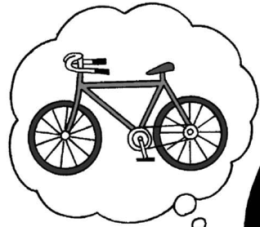
なに が ほしいですか。 | What do you want?
– – – – – – じてんしゃ が ほしいです。| I want a bicycle.
Sentence structure: noun + *particle ga + ‘ほしい | hoshii’
Asking “what kind of ~ you want”:
In Lesson 8 we learnt how to ask “what kind of ~”, and we used the question word ‘どんな | donna’. This question can be added into a sentence to ask “what kind of bicycle you want” –
どんな じてんしゃ が ほしいですか。| What kind of bicycle do you want?
– – – – – – しろい じてんしゃ が ほしいです。| I want a white bicycle.
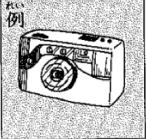
私 は あ たたらしい カメラ が ほしい です。

私 は あかい くるま が ほしいです。
2. WANT TO [VERB]
When expressing a desire to do an action, the verb needs to be conjugated, from a typical ‘ます | masu’ form to ‘たい | tai’ form. When it is in the ‘たい | tai’ form, the newly conjugated verb becomes an ‘い adjective’.
おいしい コーヒーを 飲みたいです。 | I want to drink yummy coffee.
Sentence structure: adjective + noun + *particle o + conjugated verb in ‘tai’ form
テニス を したいです。 | I want to play tennis.
日本 へ いきたいです。 | I want to go to Japan. (particle here is ‘へ | e’ because it is a place marker)
***** The particle ‘を | o’ can be replaced with ‘が | ga’
何を 買いたいですか。 | What do you want to buy?
– – – – – – あたらしい けだいでんわ を かいたいです。 | I want to buy a new phone.
いつ ほっかいどう へ いきたいですか。 | When do you want to go to hokkaido?
– – – – – – 十二月 の 休み に 北海道 へ 行きたいです。
どこ へ いきたいですか。 どうしてですか。 – practice questions!
Day #2.8.2
Lesson 12 (Part III)
- Comparative statements (between 2 objects)
- Superlative statements (asking which is the best/ most ~)
1a. COMPARATIVE – comparing 2 objects with adjectives
To compare and contrast two objects, we use the word ‘より | yori’, which is an extension of the adjective (both ‘i’ and ‘na’), like how in English there is “pretty” and “prettier“. In Japanese, ‘より | yori’ acts as the “er” part of the adjective.
If we want to posit that Japan is bigger than Singapore, we say
日本は シンガポール より 大きいです。 | Japan is bigger than Singapore.
Sentence structure: Subject that the adjective is applied to + *particle wa + Subject that the adjective is not applied to + より | yori + adjective
タイのカレーは 日本のカレーより からいです。| Thai food is spicier than Japanese food.
タイのカレーは 日本のカレーより ずっと からいです。 | Thai food is much spicier than Japanese food.
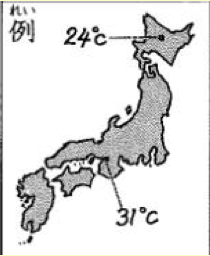
ほっかいどう は おおさか より すずしいです。| Hokkaido is cooler than Osaka.
1b. COMPARATIVE – choosing between 2 objects
‘どちら | dochira’ means “which one”, as in which between the two ~.
サッカーと やきゅうとどちら が すきですか。 | Which one do you like, soccer or baseball?
Sentence structure: Object A + *particle to + Object B + *particle to + ‘どちら | dochira’ + *particle ga + adjective
– – – – – – サッカーのほうが すきです。 | I like soccer.
いぬと ねことどちら が かわいいですか。 | Which one is cuter, cat or dog?
– – – – – – どちらも かわいいで 。 | Both are cute.
1c. COMPARATIVE – choosing one object over another (subset of choosing between 2 objects)
ぎゅうにゅうより ジュース のほが すきです。 | I like juice more than milk.
Here, the positions of the nouns change.
In 1a, A は B より [adjective] means A is more [adjective] than B.
But when choosing an object over something else, the structure becomes A より B のほうが [adjective]. This means B is more [adjective] than A.

Conversation at the table:
A: くだもの は いかがですか。
B: ありがとう ございます。
A: みかん と りんご と どちら が いいですか。
B: ええと、りんご を おねがいします。
2. SUPERLATIVE
For superlative sentences, we ask what is the “most” or the “best” out of a category. For example, to ask what one’s most favourite fruit is, we say:
くだもの で なに が いちばん すき ですか。| What fruit do you like the most?
Sentence structure: Category + *particle de + question word (‘なに | nani’ / ‘どこ | doko’) + *particle ga + ‘いちばん | ichiban’ + adjective
– – – – – – りんご が いちばん 好きです。 | I like apples the most.
Some typical question words:
- なに | nani | what
- どこ | doko | where
- いつ | itsu | when
- だれ | dare | who
Day #2.8.1
Lesson 12 (Part II)
- Differences between ‘na’ adjective endings and ‘i’ adjective endings
- Asking about past events
1. ‘NA’ vs ‘I’ ADJECTIVE ENDINGS
In short, ‘na’ adjective endings follow noun endings in terms of negatives and tenses.
‘na’ adjectives:
きのう は ひまでしたか。
– – – – – – いいえ、ひまじゃありませんでした。
‘i’ adjectives:
パーティー は たのしかった ですか。(past tense)
– – – – – – いいえ、パーティー は たのしくなかった。(past tense x negative)
2. ASKING ABOUT PAST EVENTS
とうきょう は どうでしたか。
– – – – – – とても きれいでした。(na adjective)
きのう の てんき は どうでしたか。
– – – – – – てんき は あめでした。(noun)
きのう タイ レストラン で たべました。
– – – – – – そですか。タイりょうり は どうでしたか。
とても からかったです。(i adjective)
きのう はじめて おすし を たべました。
– – – – – – どうでしたか。
とても おいしかったです。
きのう はじめて かぶき を みました。
– – – – – – どうでしたか。
とても きれいでした。
– – – – – – きのう はじめて いけばな を しました。
どうでしたか。
とても むすかしかったです。
きのう はじめて にほん の おさけ を のみました。
– – – – – – どうでしたか。
ちょっと あまかったです。
Day #2.7.2
Lesson 12 (Part I)
- The 4 different types of Japanese endings in sentences
1. Sentences that end with verbs
These sentences end with ‘ます | masu’, for example あした テストが あります。| I have a test tomorrow.

2. Sentences that end with nouns
Nouns and adjectives have similar endings. They only differ in terms of the tense that they are in. Nouns end with ‘です | desu’, for example ふじ山は ゆうめいな山です。| Mount Fuji is a beautiful mountain.

3. Sentences that end with ‘na’ adjectives
These type of sentences end with ‘です | desu’ too, さくらの はなは きれいです。| Sakura flower is pretty.

4. Sentences that end with ‘i’ adjectives
3 types of sentences end with ‘です | desu’; nouns and two kinds of adjectives. 今日は あついです。 | Today is hot.


Day #2.7.1
Lesson 11 (Part III)
- Duration – counting number of minutes, hours, days, weeks, months and years
- Asking questions such as “how long” and “how many days”
- Frequency – number of times a week, constructing sentences with frequency
1. DURATION
Minutes
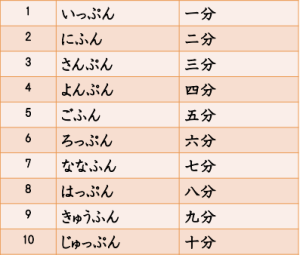
Hours
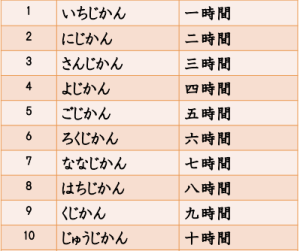
Days

Weeks

Months
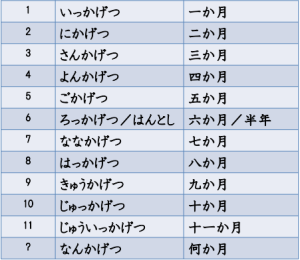
Years
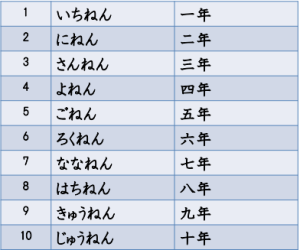
Added expressions to describe time:
10分だけ 休みます。 | I only rest for 10 minutes.
‘だけ | only’ is used after the time counter.
やすみは 日よう日だけ です。| Sunday is my only rest day.
Asking “how long”:
To ask “how long”, we use the phrase ‘どのくらい | donokurai’.
どのくらい日本ごを べんきょうしましたか。| How long have you studied Japanese?
– – – – – – 半年ぐらい べんきょうしました。| About half a year.
休みに どのくらい りょこうをしましたか。| How long was your trip during the holidays?
– – – – – – 一週かんぐらい りょこうを しました。| My trip was about 1 week.
Sentence structure: Time expression + object + *particle o + verb
Asking “how long does it take”:
うちから えきまで どのくらい かかりますか。 | How long does it take to get to the station from home?
– – – – – – バス で 15分 ぐらい かかります。 | It takes about15 mins by bus.
– – – – – – あるいて 5分です。 | 5 mins by walking.
東京から 大阪まで 新幹線で どのくらい かかりますか。 | How long does it take to get to Osaka from Tokyo by Shinkansen?
– – – – – – 3時間 かかります。| It takes 3 hours.
うちから 大学まで どのくらい かかりますか。 | How long does it take to get to school from home?
– – – – – – でんしゃで 2 時間 かかります。| It takes 2 hours by train.
うちから MRTのえきまで どのくらい かかりますか。| How long does it take to get to the MRT station from home?
– – – – – – バスで 1 0 分 ぐらい かかります。| It takes 10 minutes by bus.
2. FREQUENCY
To count how many times a week that something happens, we use ‘かい | kai’, which is “times”.
1週間に 何かい 日本語を べんきょうしますか。 | In one week how many times do you study Japanese Language?
– – – – – – 1週間 に 2 かい 日本語を べんきょうします。 | In one week I study Japanese Language twice.
Sentence structure: time expression + *particle ni + frequency + noun + *particle o + verb
1 か月に 何かい えいがを 見ますか。| How many times do you watch movies in a month?
– – – – – – 3 かい 見ます。| I watch 3 times.
1 年に 何かい りょこうを しますか。| How many times do you go on a trip every year?
– – – – – – 1 かい りょこうを します。| I go on a trip once.
Day #2.6.2
Lesson 11 (Part II)
- More counters in a sentence, different particles for different verbs
Examples of using different verbs and particles:
For existence, we use particle ‘が | ga’ and verb ‘あります | arimasu’
りんご が いつつ あります。| There are 5 apples.
For verbs like buying or asking for something at a shopping mall, we use the particle ‘を | o’
りんご を いつつ ください。 | 5 apples please.
りんご を いつつ 買いました。| I bought 5 apples.
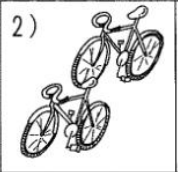
じてんしゃ を 何だい 買ましたか。 | How many bicycles did you buy?
– – – – – – にだい 買ました。| I bought 2.
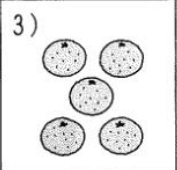
みかん を いくつ 食べましたか。 | How many oranges did you eat?
– – – – – – いつつ 食べました。| I ate 5.

にもつ を いくつ おくりましたか。| How many parcels did you send out?
– – – – – – やっつ おくりました。 。 | I sent 8.

Waitress: いらっしゃいませ!| Welcome!
Customer: サンドイッチ を ふたつ ください。| 2 Sandwiches please.
Waitress: かしこまりました。| Certainly.

Waitress:いらっしゃいませ!| Welcome!
Customer: ジュース を ひとつ ください。| 1 Juice please
Waitress: かしこまりました。| Certainly.

Waitress: いらっしゃいませ!| Welcome!
Customer: アイスクリーム を よっつ ください | 4 Ice creams please
Waitress: かしこまりました。| Certainly.
We use counters to solve math problems too:
もんだいを つくりましょう | Let’s solve a problem
きのう りんごを みっつ 買いました。 今日 また ふたつ 買いました。 今、ぜんぶで いくつ ありますか。| Kinou ringo o mittsu kaimashita. kyou mata futatsu kaimashita. Ima, zenbude ikutsu arimasu ka? | Yesterday, I bought 3 apples. Today, I bought 2 more. Now, how many do I have altogether?
今、りんご が いつつ あります。| Ima, ringo ga itsutsu arimasu. | Now, I have 5 apples.
休みに りょこうを しました。おみやげの シャツを 8まい 買いました。友だちに 3まい あげましたそれから、ちちに 1まいと ははに 2まい あげました。今、シャツは 何まい ありますか。| I went on a trip in the holidays. I bought 8 shirts as souvenirs. I gave 3 shirts to my friends. I gave 1 to my father and 1 to my mother. Now, how many shirts do I have?
今、シャツ が みっつ あります。| Now, I have 3 shirts.
Day #2.6.1
Lesson 11 (Part I)
- Counting: general objects, people, machines, flat objects
- Using counters in a sentence
1. GENERAL OBJECTS:
To count general objects such as fruits, a specific numbering goes like this –
ひとつ | 1
ふたつ | 2
みっつ | 3
よっつ | 4
いつつ | 5
むっつ | 6
ななつ | 7
やっつ | 8
ここのつ | 9
とお | 10
To ask “how many”, ‘いくつ | ikutsu’ is used.
2. PEOPLE:
Counting people –
ひとり| 1
ふたり| 2
さんにん | 3
よにん | 4
ごにん | 5
ろくにん | 6
ななにん | 7
はちにん | 8
きゅうにん | 9
じゅうにん | 10
To ask “how many people”, ‘なんにん | nannin’ is used.
3. MACHINES:
Counting machines –
いちだい | 1
にだい | 2
さんだい | 3
よんだい | 4
ごだい | 5
ろくだい | 6
ななだい | 7
はちだい | 8
きゅうだい | 9
じゅうだい | 10
4. FLAT OBJECTS:
Counting flat objects – ~ まい
いちまい | 1
にまい | 2
さんまい | 3
よんまい | 4
ごまい | 5
ろくまい | 6
ななまい | 7
はちまい | 8
きゅうまい | 9
じゅうまい | 10
5. USING COUNTERS IN SENTENCES:
The line of counting in sentences goes – object + particle ga + counter + verb – apples + particle + 5 + existence
りんご が いくつ あります か。| How many apples are there?
– – – – – – いつつ あります。| There are 5 apples.

りんご が いくつ あります か。
– – – – – – みっつ あります。
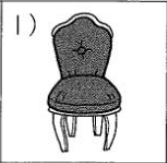
いす が いくつ あります か。
– – – – – – ひとつ あります。

たまご が いくつ あります か。
– – – – – – よっつ あります。
Day #2.5.2
Lesson 10 (Part III)
- Describing in detail
- Asking for something – shopping “do you have ~”
- North / South / East / West
 「みんな の にほんご」は ありません か。|”Minna no Nihongo” wa arimasen ka? | Do you have the “Japanese Language” book?
「みんな の にほんご」は ありません か。|”Minna no Nihongo” wa arimasen ka? | Do you have the “Japanese Language” book?
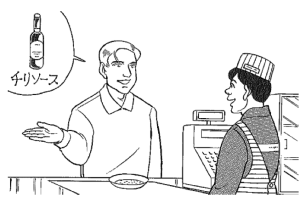
チリソース は ありません か。| Do you have chilli sauce?
– – – – – – みぎの おくに スパイス・コーナーが あります。| Deep inside the spice corner.


すみません、ノート は ありません か。| Excuse me, do you have notebooks?
– – – – – – ノート ですか、 あの いちばん の たな です。| Notebooks? At the top most shelf.
すみません、でんち は ありません か。| Excuse me, do you have batteries?
– – – – – – でんち ですか、あの いちばん した の たな です。| Batteries? At the bottom most shelf.

すみません、けしゴム は ありません か。| Excuse me, do you have erasers?
– – – – – – けしゴム です か、あの うえ から さんたんめ の たな です。| Erasers? Third shelf from the top.

すみません、セロテープ は ありません か。 | Excuse me, do you have scotch tape?
– – – – – – セロテープ です か、あの した から にたんめ の たな です。| Scotch tape? Second shelf from the bottom.
2. NORTH / SOUTH / EAST / WEST

北海道 | Hokkaido – きた | North
東京都 | Tokyo – ひがし | East
大阪府 | Osaka – にし | West
京都府 | Kyoto – みなみ | South



